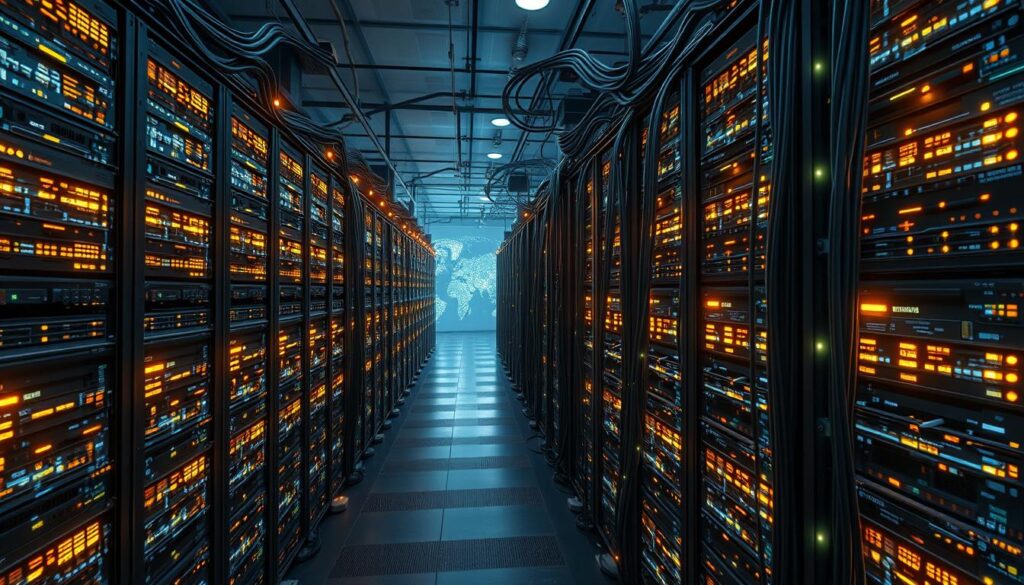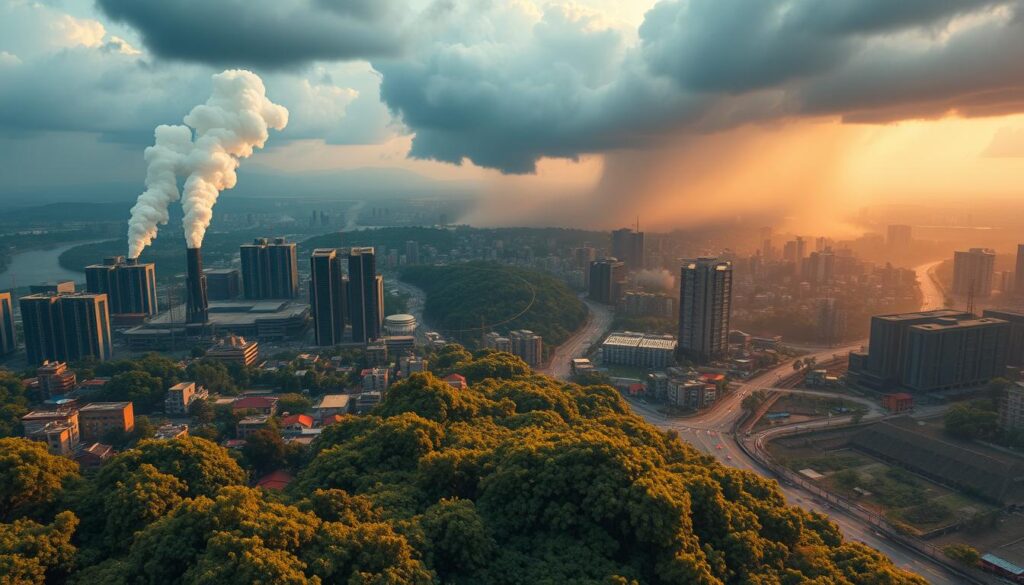As we get closer to Earth Day 2024, the world is seeing more extreme weather like wildfires and floods. Internet usage and climate change is huge. It can help and also harm the environment.
The Internet makes remote work possible, which cuts down on emissions. It also connects people working on climate solutions worldwide. But, it needs electricity to work, and making devices creates e-waste.
The Internet’s setup needs to change to keep working as the climate changes. People spend over 40% of their time awake online. Social media and streaming videos are the most popular online activities.
Key Takeaways
- The Internet plays a dual role in climate change, both reducing emissions and contributing to environmental challenges.
- Remote work and digital connectivity can help mitigate climate impact, but the Internet’s infrastructure has a significant carbon footprint.
- Advancements in sustainable technology, energy-efficient data centers, and renewable energy sources are crucial for the future of the Internet and climate change.
- Balancing the benefits and drawbacks of the Internet’s environmental impact will be a critical priority in the years ahead.
- Individuals can make eco-friendly choices in their online habits and support companies and initiatives working to “green the Internet.”
Understanding the Internet’s Environmental Impact
Our use of the internet is growing fast. This growth has a big environmental cost. From the power-hungry data centers to the making of internet devices, the internet’s carbon footprint is huge and getting bigger.
Digital Carbon Footprint Basics
The internet uses over 400 terawatt-hours of electricity every year. This adds up to about 3.7% of global greenhouse gas emissions. Data centers, key to the internet, use a lot of energy. They often use fossil fuels to get the power they need.
Global Energy Consumption Statistics
In 2022, data centers, AI, and cryptocurrencies used 460 terawatt-hours of electricity. By 2026, this could go up to 620-1,050 terawatt-hours. As we use more digital tech, the energy needed will keep going up. This shows we need to make the internet more sustainable.
Environmental Cost of Data Centers
Data centers are vital for the internet but harm the environment. One data center can use up to 5 million gallons of drinking water every day. This can lead to water shortages in some places. Also, watching a one-hour video can produce about 55g of CO2e. This is like microwaving four bags of popcorn. Devices used by consumers cause over half of the carbon emissions from streaming.
As we rely more on the internet, its environmental impact is clear. We must tackle the energy use and carbon emissions of the internet. This is key in the battle against climate change.
Internet Usage and Climate Change: A Double-Edged Sword

The internet is a big part of our lives. But it also has a big impact on the environment. Remote work and telecommuting can cut down on car trips. This means less pollution from cars.
A study found that if half of U.S. workers worked from home, it could save a lot of greenhouse gases. This is about 54 million tons every year.
The digitalization of services like e-books and online banking uses less stuff. This means less carbon emissions. The internet also helps create smart technologies like smart grids. These make homes use energy better.
But, online shopping has made our carbon footprint bigger. It’s easy to shop online, but it’s bad for the planet. The packaging, shipping, and data centers use a lot of energy.
Carbon offsetting for internet usage is a new way to help the planet. It’s a way to make up for the bad things the internet does.
The internet is both good and bad for the planet. We can make it better by using it wisely. By being smart about our digital lives, we can help the planet.
The Growing Power Demands of Digital Infrastructure

Our use of digital tech is growing fast. This means more energy for data centers, networks, and devices. Data centers use a lot of power for servers and cooling. Networks also need a lot of energy for data to move around.
When we make devices like phones and laptops, it harms the planet. The mining for rare earth minerals is bad for the environment. Using the internet a lot can also hurt the planet, with about 40% of carbon emissions coming from it.
Data Center Energy Requirements
Data centers are key to our digital world but harm the environment. They use a lot of electricity for servers and cooling. The U.S. Department of Energy says data centers could use 9% of the nation’s electricity by 2030.
Network Infrastructure Power Consumption
Networks like fiber cables and satellites also use a lot of energy. As we connect more, we need more power for data. The International Energy Agency says we might need 160 to 590 terawatt-hours more by 2026.
Device Manufacturing Impact
Devices like phones and laptops also hurt the planet. Mining for materials is bad for nature. Making these devices also uses a lot of energy, adding to carbon emissions.
We must find ways to use less energy as we go digital. Using renewable energy and making devices more efficient is key. This will help fight climate change and protect our planet.
Climate Threats to Internet Infrastructure

The internet that connects us all is facing big challenges due to climate change. Rising sea levels and extreme weather are testing the internet’s strength. This is a big worry for our digital lives.
Rising sea levels are a big threat to the internet’s undersea cables. These cables carry most of the world’s internet traffic. If they get flooded or eroded, it could cut off internet access in many places.
Natural disasters like wildfires and floods are also damaging the internet’s land-based systems. A study looked at how these disasters could affect the internet in the Pacific Northwest. It showed we need to make the internet stronger to handle these problems.
Groups like the Internet Society Foundation are working on this issue. They are funding research to make the internet more eco-friendly. This includes finding ways to protect the internet from climate threats.
With more than 5 billion people online, we must protect the internet. We need to make sure it’s strong and green. This way, our digital world can stay safe and open, even as the climate changes.
Renewable Energy Solutions for Digital Technology

The internet and digital world are growing fast. This makes us worry about the environment. But, good news is coming. Big tech companies and new startups are finding ways to use green energy for the digital world.
Green Data Centers
Big names like Google, Apple, and Microsoft are moving their data centers to green energy. They use wind and solar power. This cuts down on carbon emissions and shows others the way.
New tech in efficient cooling systems and AI to save energy in data centers helps a lot. It makes the internet’s energy needs smaller.
Sustainable Web Hosting Options
The Green Web Foundation is checking how web hosting affects the environment. They push for green web hosting. Now, there are more sustainable web hosting choices. These use renewable energy for internet infrastructure.
Energy-Efficient Networks
New tech in energy-efficient networks is making a difference. Low-power 5G technology and smart grid integration use less energy. Companies are also making devices in a greener way. They use recycled materials and try to waste less.
By using these renewable energy solutions for digital technology, we can make the internet and our planet more sustainable.
Remote Work and Environmental Benefits
Remote work has grown a lot since the COVID-19 pandemic. It lets people work from home. This cuts down on daily commutes and lowers carbon emissions from cars.
A study by Global Workplace Analytics found big savings. If half of U.S. workers worked from home, it could save 54 million tons of greenhouse gases each year. Digital services in healthcare and education also help the environment.
Remote work means better schedules and more time for personal things. This makes employees happier, with up to 20% more happiness than office work.
It also means less traffic and cleaner air. With fewer offices, there’s less need for energy for heating, cooling, and lights. This helps the planet too.
Even though some bosses want workers back in the office, most people want to keep working from home. This shows how much remote work has changed lives and the environment.
In summary, remote work has shown it can greatly reduce environmental harm. As technology keeps improving, remote work’s benefits will grow. These include less pollution, better work-life balance, and eco-friendly practices.
Emerging Technologies and Their Climate Impact
Technology keeps getting better, but we must think about its effect on the environment. Innovations like artificial intelligence (AI), blockchain, and the Internet of Things (IoT) are key. They have great potential but also new challenges for energy use and sustainability.
AI and Machine Learning Energy Consumption
Training big language models like ChatGPT-3 needs a lot of power. One request to ChatGPT can use 10 times more electricity than a Google search. As AI and machine learning grow, so will their energy needs, possibly stressing power grids.
Blockchain Environmental Concerns
Blockchain, the tech behind Bitcoin, also worries the environment. Mining and verifying transactions on blockchain uses a lot of energy. In Ireland, AI and blockchain could use up to 35% of the country’s energy by 2026.
IoT Sustainability Challenges
The Internet of Things (IoT) makes smart tech that saves energy. But, it also means more devices and more e-waste. Every year, we make over 53 million metric tons of e-waste, with only 20% recycled.
As these techs grow, we must focus on green solutions. We need to tackle AI, blockchain, and IoT’s energy and waste issues. This way, we can make our digital world more eco-friendly.
Building Resilient Digital Infrastructure
Climate change makes keeping the internet safe more important than ever. We need to make our digital world strong against climate change. The Internet Society Foundation’s “Greening the Internet” program helps fund research to make the internet stronger.
One way to check if a country’s internet is strong is the Internet Resilience Index (IRI). Building local networks and Internet Exchange Points (IXPs) helps a lot. This way, communities can keep their internet on even when big networks fail.
Using green web design and development is also key. We can make the internet use less energy and be kinder to the planet. This helps create a sustainable internet ready for climate challenges.
As we rely more on the internet, keeping it safe is essential. We can do this by working together, doing research, and using green practices. This way, we can make a climate-conscious web design and a strong digital world for the future.
- The Internet Society Foundation’s “Greening the Internet” program has funded research to enhance internet resilience.
- The Internet Resilience Index (IRI) measures the resilience of countries’ internet infrastructure.
- Encouraging the development of local community networks and Internet Exchange Points (IXPs) can improve resilience.
- Implementing sustainable practices in web design and development can contribute to a more resilient digital infrastructure.
Conclusion
The Internet and climate change are linked in many ways. The Internet’s use and setup add to carbon emissions. Yet, it also offers chances to fight climate change.
Remote work, digital tools, and smart tech can help lessen our harm to the planet. These steps are key to making the Internet a part of the solution.
We must use the Internet in ways that are good for the planet. This means using it in a way that’s both fast and careful. We need to use less raw materials in devices to avoid harming the Earth.
I’m optimistic about the Internet’s future. We can make a better world with new ideas, teamwork, and a focus on the environment. Together, we can make the digital world help fight climate change.




